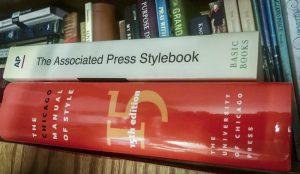A Slippery Slope to Sloppy Style
In the nearly four decades that I have been writing and occasionally getting paid for it (although mainly I made a living editing and making sure the bills got paid at whatever newspaper I ran) an Associated Press stylebook was never out of reach. It is the go-to manual of style and usage for newspapers. I have largely adhered to its precepts even though I no longer write for newspapers. Thus, I view with a modicum of alarm some recent changes to the s

tylebook recently announced. Other changes make sense, and I have conformed accordingly.
I attended the University of Missouri School of Journalism for one semester as a graduate student, before transferring to the University of Texas because I could no longer afford the out-of-state tuition. I took my only newswriting course at Mizzou. It’s where I bought my first AP Stylebook and had drilled in my head, while pounding out stories for class on an IBM Selectric typewriter, to use “more than” if numerals are involved: As in: More than 5,000 people attended the rally. Not: Over 5,000 people attended the rally.
Then, five years ago, AP decided over and more than were interchangeable. Thirty-five years of me telling reporters and journalism students not to use over with numerals got tossed out the window. I steadfastly refuse to change my ways, not that anyone actually cares. These days, I don’t have anyone to correct except myself.
I likely inherited this fussiness with language usage from my mother. She couldn’t stand the Southern habit of saying, I’m coming over your house. Her French-Canadian Yankee spine stiffened as she pointed out that in nearly all cases it would be physically impossible to go over one’s house, unless equipped with a broomstick or hot-air balloon. I’m coming to your house is the proper way to say it, she would say. Meh, Mom, may she rest in peace.
Also in 2014, AP decided all state names in stories (not datelines) should be spelled out. I applauded this decision, because even after all those decades I would have to reach for the stylebook to check how to properly abbreviate Montana, for example — Mont., if you care. The AP state abbreviations were different from postal abbreviations, which made no sense. Good riddance. I can spell Mississippi, so no need to abbreviate.
Of the latest changes, I again favor one while refusing to accept another. In that dreary classroom in Columbia, Mo., I was taught to always spell out percent when paired with a number, as in: The candidate won the election with 52.8 percent of the votes cast. Using the percentage symbol — % — was forbidden. For a news organization that valued brevity, this seemed like a waste of space — seven unnecessary characters. I dutifully complied when drawing a paycheck from newspapers but quit the habit soon after.
Along that line is a pet peeve that I almost certainly will take to my grave, hopefully in the distant future. Many journalists, being math-challenged, which is why they entered the field instead of accounting, have a hard time understanding the difference between percent and percentage points. To illustrate, if inflation rises from 3% to 5%, it has risen two percentage points. That also means it has risen 66%. Far too often, a reporter would write: Inflation rose from 3% to 5%, an increase of 2%. No, no, a thousand times no.
Alas, the AP has decided to do serious damage to clarity by modifying the rules about using hyphens in a compound modifier phrase: “If the meaning is clear and unambiguous without the hyphen.” For example, Brady scored a first-quarter touchdown is how we used to write it. AP has decreed the hyphen is unneeded: scored a first quarter touchdown.
I view this as a slippery slope down the road to sloppy style. I consider hyphens to be my writing friend, an effective but unobtrusive way to achieve maximum clarity. The lowly hyphen doesn’t take up any extra space. It tells the reader that these two words go together. Maybe the reader would comprehend that without the hyphen. But maybe the reader knows nothing about football and first quarters. She could be a soccer fan. Soccer has neither quarters nor touchdowns.
As for me, I will continue to sprinkle hyphens about.
Leave a reply
Fields marked with * are required











